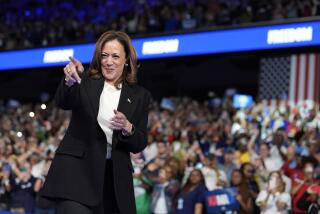Negative Campaign Repelled Some Voters
A slashingly negative campaign and alienation among blacks and Latinos combined to produce the record low turnout last week that gave Gov. Gray Davis the political fright of his life. A lack of competitive legislative and congressional races, as well as the absence of substantive debate, also contributed to the widespread apathy and estrangement, according to experts assessing the mass voter boycott.
“Usually, high turnout is built on hot issues and hot campaigns,” said one political analyst, Antonio Gonzalez. “In this election we had neither.”
A scant 44.9% -- or roughly 6.9 million people -- of California’s registered voters went to the polls Tuesday, according to the secretary of state’s office, which keeps the official tally. Roughly 750,000 absentee votes were cast; when those have been counted it is expected that the turnout will rise to just about 50% of California’s 15 million registered voters.
That would be the lowest turnout in any statewide race since reliable record keeping began in California in 1910. The previous low was four years ago, when 58% of Californians showed up at the polls.
The shrunken turnout also changed the makeup of Tuesday’s electorate from the one that gave Davis his first term in a 20-point landslide in 1998. Davis won reelection against his badly battered opponent, Los Angeles businessman Bill Simon Jr., by a closer-than-expected 47% to 42%.
The electorate Tuesday was much whiter and slightly more Republican than in 1998, according to a Los Angeles Times exit poll.
White voters made up 76% of the electorate, compared with 64% four years ago. Democratic turnout declined slightly, from 48% to 46%, but the percentages of Republicans and independents increased from 39% to 40% Republican and 8% to 10% independent.
The most dramatic shift came in the falloff of minority voters -- the Democratic base -- which also helps explain the dramatic drop in Davis’ support.
Latinos declined from 13% of the electorate in 1998 to 10% on Tuesday, the first drop in Latino turnout since it began steadily rising in California in 1986. The falloff in the black vote was even more dramatic, from 13% to 4% of the statewide electorate, according to the exit poll. Translated, that means that roughly 800,000 fewer African Americans and 350,000 fewer Latinos cast ballots Tuesday than in 1998.
The flagging of enthusiasm among core Democratic groups was most evident in the high stay-at-home rates in the party strongholds of Los Angeles, San Francisco and Alameda counties, where combined turnout fell by more than 12% from 1998.
Turnout in Republican counties also slipped, but the absent Democratic voters and the decision of some party voters to side with minor candidates combined to cut dramatically into the governor’s showing. Davis won 1.7 million fewer votes than he had in 1998, before all the absentee ballots were counted, but Simon got only about 400,000 fewer than the 1998 GOP nominee Dan Lungren.
At least part of the reason for the falloff was a lack of serious competition in the 113 legislative and congressional races across California. That resulted from the redrawing of the state’s political boundaries in a bipartisan incumbent-protection plan, which eliminated true competition in all but about a dozen of the contests on Tuesday’s ballot.
“We always depend on the big races, especially where there’s congressional and legislative races in the same area, to push turnout of our base constituencies,” said Gale Kaufman, a Democratic strategist involved Tuesday in several contests. “This time there weren’t enough of those to have any impact.”
But analysts say the biggest factor throwing a soggy blanket over the electorate was the unremittingly negative tone of the campaign waged by the two leading candidates for governor. In a testament to their dubious achievement, Davis and Simon both ended the campaign disliked by roughly six in 10 of those who bothered to vote, according to the Times poll. Anecdotally, the distaste among those who refused to vote was even more vehement.
Strategy No Secret
Strategists for Davis, who was widely unpopular heading into his reelection campaign, made no secret of their strategy: Destroy his opponent so that voters, however grudgingly, would see the incumbent as a preferable alternative.
Garry South, the mastermind of Davis’ campaign, called the contest “damaged goods versus defective product.” So the governor and his strategists “bludgeoned Simon with a blunt object, and it was not a pretty sight,” South said.
But it proved devastatingly effective -- and greatly off-putting.
Negative campaigning “just drops the mood of the electorate like a rock,” said Bruce Cain, director of UC Berkeley’s Institute for Governmental Studies.
Although Democrats spent $9 million on get-out-the-vote efforts, Cain pointed out, they spent tens of millions more on advertising whose effect was “turning people off. Bottom line, if you spend more money turning people off than turning people on, the turnout will go down.”
Simon also had some complicity. While he called himself “the candidate of ideas,” the gist of his campaign was attacking Davis as a corrupt governor, an assault he stepped up with a last blast of advertising, after even his own strategists had told him he could not win.
“Davis said, ‘Simon’s a fascist.’ Simon said, ‘Davis is a crook.’ That was the campaign,” said Gonzalez, president of the William C. Velasquez Institute, a nonpartisan think tank that focuses on the Latino community. “That’s not very exciting for voters.”
“It was like a purple elephant’s in the room,” Gonzalez went on. “The budget crisis, the education crisis, the health care crisis -- and we’re sitting, having coffee, ignoring the purple elephant.”
There were also more specific gripes among key Democratic constituencies.
Davis has long been a political centrist, balancing his environmentalism and support for abortion rights with a tough stance on law-and-order issues and a generally pro-business attitude.
Many Democrats were willing to overlook some areas of disagreement when he first ran for governor -- after all, Republicans had held the office for 16 years. But they were less forgiving once Davis took over and failed to deliver on a liberal agenda, even though he had never promised one.
“That sort of ticked off all of us who thought we knew this guy and he’d be true blue,” said Alice Huffman, a Democratic activist of more than 30 years. “He turned out to be a little different than we anticipated.”
Davis’ soured relations with the California Teachers Assn. are illustrative.
The labor group contributed $1.2 million to his 1998 campaign. But alienated by the governor’s push for standardized testing and other disagreements over education policy, the association gave only $62,000 to Davis’ reelection effort, all but $10,000 of it early in his term.
More damaging still was the revelation from the association’s president, Wayne Johnson, that the governor had unsuccessfully sought a $1 million contribution while discussing official business.
Although the solicitation was not illegal, it damaged Davis’ image and fueled attacks on him as a “pay-to-play” governor, as Simon frequently put it.
In other policy areas, many African Americans felt the governor had snubbed blacks in some of his early appointments and stinted in his support for crime prevention programs.
Also deeply rankling was his stance on racial profiling, said Huffman, president of the state conference of the National Assn. for the Advancement of Colored People.
Despite strong lobbying, Davis vetoed a 1999 bill that would have required local police to collect racial data, and then lobbied against a second bill that was scrapped before reaching the Assembly floor. Last year, a third racial profiling bill was stripped of any data collection requirement at the behest of the governor.
“Many of us were disillusioned,” Huffman said.
Disenchanted Minorities
Many black activists were also pragmatic, figuring that Davis was better than Simon. “But it’s hard to turn around to your troops and say, ‘OK, let’s get to work,’ ” Huffman added. “They say, ‘For this guy?’ ”
Although African Americans supported Davis in roughly the same proportion as in 1998, with about eight in 10 backing the governor, tens of thousands registered their feelings by choosing not to vote.
A similar disenchantment was evident in the state’s growing Latino community.
At the start of his administration, Davis clashed with Lt. Gov. Cruz Bustamante, a fellow Democrat, over parking spaces and, more seriously, immigration policy. Then, in the final weeks of the campaign, Davis produced a backlash among some Latino leaders by vetoing a bill to let illegal immigrants obtain state driver’s licenses if they applied for U.S. citizenship.
Despite Simon’s efforts to capitalize on their upset, Latino voters stayed mostly loyal to Davis. But there was a notable drop-off, not just in turnout, but also in the degree of Davis support.
In 1998, 71% of Latinos voted for the Democrat, compared with 65% on Tuesday. Green Party candidate Peter Camejo received 6% of the Latino vote, with the rest going to other candidates.
“The same thing happened as with everyone else,” Gonzalez said. “We were offended by the brutally negative nature of the campaign. “So people stayed home.”
*
Times staff writer Matea Gold contributed to this report.
More to Read
Get the L.A. Times Politics newsletter
Deeply reported insights into legislation, politics and policy from Sacramento, Washington and beyond. In your inbox three times per week.
You may occasionally receive promotional content from the Los Angeles Times.











